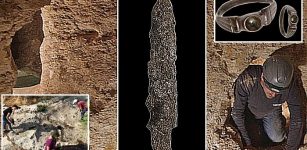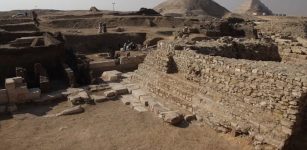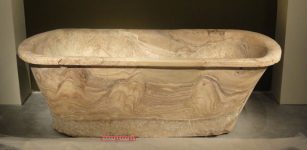Spectacular Vespasianus Titus Tunnel – An Ancient Roman Engineering Marvel
A. Sutherland - AncientPages.com - One of the ancient Roman engineering marvels is located in Samandag, Turkey. This structure, known as the Vespasianus Titus tunnel, is the world's largest man-made tunnel.
Vespasianus Titus Tunnel, an ancient water tunnel built in the 1st century AD during the reign of the Roman emperor Vespasianus within the boundaries of Seleucia Pieria (Samandag), Turkey. Image credit: Carole Raddato - CC BY-SA 2.0
The 1,380-meter-long tunnel was built (entirely by human resources) as a water channel in the 2nd century. Today the channel is dry but still worth admiring the ancient skills of the Roman builders and engineers.
During the reign of Emperor Vespasian (69-79 AD), the Roman governors of Seleucia Pieria (Samandag), the port city for Antioch ad Orontes (Antakya), decided to divert a river.
Several Roman emperors were very concerned and ordered canals to be dug to prevent this process, but in the end, this was in vain.
The entrance of the Vespasianus Titus Tunnel, an ancient water tunnel built in the 1st century AD during the reign of the Roman emperor Vespasianus within the boundaries of Seleucia Pieria (Samandag), Turkey. Image credit: Carole Raddato - CC BY-SA 2.0
The city was under the threat of floods descending from the mountains and flowing through the town, and the harbor was silted up and became inoperative. The Roman emperor, Vespasianus, ordered the building of a tunnel by digging the mountain to divert the floodwaters threatening the harbor.
Legionnaires, sailors, and prisoners received the order to cut a channel along and through the rock for about 1.4 km (nearly a mile). This structure is one of the most remarkable Roman engineerings
in the region. It is not only because the tunnel's size but also ingenuity of the people who created it.
The construction of the Titus tunnel did not start during the reign of Emperor Titus (79-81 AD). It began under Titus' father Vespasian time, and ended under Emperor Antoninus Pius in mid-2nd century AD.
The tunnel consists of several sections, and the system's hydraulic capacity is based on the determination of water surface levels through step-by-step integration.
Building inscription of the tunnel naming the emperors Vespasian and Titus. Image credit: Carole Raddato - CC BY-SA 2.0
The tunnel is considered to be a Roman engineering marvel. It was cut through solid rock in a relatively short period, and the workers' job was challenging. It also offers an excellent example of Romans capable of manifesting ingenuity in facing and solving problems such as flooding.
According to an inscription, the tunnel was not finished until the reign of Antoninus Pius (138-161).
The inscription reads: "Divine Vespasian and Divine Titus made it."
There are also some Greek words in the inscription's lower part that was most likely added much later.
The Vespasianus Titus tunnel - an impressive masterpiece of the Roman engineers - has survived until today without much damage.
Written by – A. Sutherland AncientPages.com Staff Writer
Updated on January 24, 2023
Copyright © AncientPages.com All rights reserved. This material may not be published, broadcast, rewritten or redistributed in whole or part without the express written permission of AncientPages.com
Expand for referencesReferences:
Frank Sear F. Roman Architecture
Erdkamp P. The Cambridge Companion to Ancient Rome
More From Ancient Pages
-
 Pre-Clovis, Paisley Caves: Archaeologists Identified The Earliest Population Of North America
Archaeology | Jul 16, 2020
Pre-Clovis, Paisley Caves: Archaeologists Identified The Earliest Population Of North America
Archaeology | Jul 16, 2020 -
 Hiding Tunnel Complex Dated To The Bar Kokhba Revolt Revealed Near The Sea of Galilee
Archaeology | Apr 23, 2024
Hiding Tunnel Complex Dated To The Bar Kokhba Revolt Revealed Near The Sea of Galilee
Archaeology | Apr 23, 2024 -
 Cacao Originated 1,500 Years Earlier Than Previously Thought And Comes From South America
Archaeology | Oct 30, 2018
Cacao Originated 1,500 Years Earlier Than Previously Thought And Comes From South America
Archaeology | Oct 30, 2018 -
 12,000-Year-Old Rock Art In North America – Dating Petroglyphs In The American West
Archaeology | Mar 4, 2022
12,000-Year-Old Rock Art In North America – Dating Petroglyphs In The American West
Archaeology | Mar 4, 2022 -
 12,000-Year-Old Stones Found In Israel Could Be Earliest Evidence Of Wheel-Like Technology
Archaeology | Nov 13, 2024
12,000-Year-Old Stones Found In Israel Could Be Earliest Evidence Of Wheel-Like Technology
Archaeology | Nov 13, 2024 -
 Huge Unknown Ancient Lost World Discovered Inside Giant Sinkhole In China
News | May 19, 2022
Huge Unknown Ancient Lost World Discovered Inside Giant Sinkhole In China
News | May 19, 2022 -
 Neanderthals Buried Their Dead And Developed Spirituals Beliefs – Did Neanderthals Practice Religion?
Featured Stories | Dec 28, 2016
Neanderthals Buried Their Dead And Developed Spirituals Beliefs – Did Neanderthals Practice Religion?
Featured Stories | Dec 28, 2016 -
 Surprising Discovery Of Ancient Roman Salt Factory In England
Archaeology | Oct 8, 2020
Surprising Discovery Of Ancient Roman Salt Factory In England
Archaeology | Oct 8, 2020 -
 Ancient Stone Kitchens And Unlocking A Treasure Trove Of Culinary Secrets
Archaeology | Mar 31, 2025
Ancient Stone Kitchens And Unlocking A Treasure Trove Of Culinary Secrets
Archaeology | Mar 31, 2025 -
 On This Day In History: Battle Of Svolder One Of Greatest Battles of Viking Scandinavia Was Fought – On Sep 9, 1000
News | Sep 9, 2016
On This Day In History: Battle Of Svolder One Of Greatest Battles of Viking Scandinavia Was Fought – On Sep 9, 1000
News | Sep 9, 2016 -
 Mystery Of Vitrified Scottish Fort Dun Deardail And Ancient Myth Deirdre Of The Sorrows: Is There A Prehistoric Connection?
Civilizations | Feb 5, 2021
Mystery Of Vitrified Scottish Fort Dun Deardail And Ancient Myth Deirdre Of The Sorrows: Is There A Prehistoric Connection?
Civilizations | Feb 5, 2021 -
 Strange Tale Of Mysterious Thousand-Year-Old Underground Network Of Caves And Encounters With Subterranean Dwellers
Ancient Mysteries | Jul 13, 2022
Strange Tale Of Mysterious Thousand-Year-Old Underground Network Of Caves And Encounters With Subterranean Dwellers
Ancient Mysteries | Jul 13, 2022 -
 El Volcán: Mysterious Volcano-Shaped Pyramid With Never Revealed Secrets In Peru
Archaeology | Jun 6, 2017
El Volcán: Mysterious Volcano-Shaped Pyramid With Never Revealed Secrets In Peru
Archaeology | Jun 6, 2017 -
 Hidden 2,000-Year-Old Roman Road Uncovered In Worcestershire Could Be Of ‘Global Importance’
Archaeology | Nov 12, 2022
Hidden 2,000-Year-Old Roman Road Uncovered In Worcestershire Could Be Of ‘Global Importance’
Archaeology | Nov 12, 2022 -
 Two-Million-Year-Old DNA Opens A ‘Game-Changing’ New Chapter In The History Of Evolution
Archaeology | Dec 7, 2022
Two-Million-Year-Old DNA Opens A ‘Game-Changing’ New Chapter In The History Of Evolution
Archaeology | Dec 7, 2022 -
 Pyramid Of Unknown Ancient Egyptian Queen And Hundreds Of Mummies Discovered In Saqqara
Archaeology | Nov 17, 2022
Pyramid Of Unknown Ancient Egyptian Queen And Hundreds Of Mummies Discovered In Saqqara
Archaeology | Nov 17, 2022 -
 Where Were Herod The Great’s Royal Alabaster Bathtubs Quarried?
Archaeology | May 17, 2022
Where Were Herod The Great’s Royal Alabaster Bathtubs Quarried?
Archaeology | May 17, 2022 -
 Early Māori Settlement On The Subantarctic Islands -Uncovering Some Of The Unknown
Archaeology | Jul 20, 2023
Early Māori Settlement On The Subantarctic Islands -Uncovering Some Of The Unknown
Archaeology | Jul 20, 2023 -
 How Did Vikings Worship Their Gods?
Ancient History Facts | May 25, 2016
How Did Vikings Worship Their Gods?
Ancient History Facts | May 25, 2016 -
 Shining Swords: Magical Artifacts That Symbolized Power, War, Punishment And Righteousness
Featured Stories | Nov 20, 2024
Shining Swords: Magical Artifacts That Symbolized Power, War, Punishment And Righteousness
Featured Stories | Nov 20, 2024



